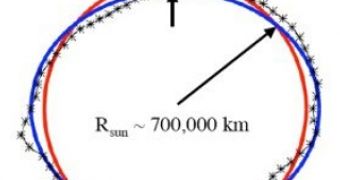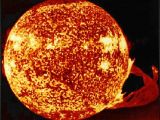The RHESSI spacecraft provided specialists with enough accurate data based on which they were finally able to calculate far more precisely the exact roundness of our solar system's star. These measurements indicated that the Sun is not a perfectly round body, instead they revealed the small differences between the equatorial and polar radius which cause its oblate shape.
Reuven Ramaty High Energy Solar Spectroscopic Imager (RHESSI, or less frequently known as “Explorer 81”) is the sixth mission of NASA's Small Explorer mission series (SMEX), which was launched on February 5th 2002. The RHESSI probe was designed to photograph the Sun's flares in energy photons, from the soft X rays (about 3 keV) up to gamma rays (as high as approximately 20 MeV), as well as to ensure high-resolution spectroscopy up to gamma-ray energies of around 20 MeV. Also, it is able to perform spatially-resolved spectroscopy with high spectral resolution. But, although it was never meant to observe the Sun's roundness, it eventually proved perfect for this task.
Using the information it sent back, experts revealed that along its evolution, the Sun formed a thin “cantaloupe skin” which noticeably caused its oblateness to appear larger (the equatorial radius seems bigger than the polar one). The co-author of the study, Hugh Hudson from UC Berkeley states, “The sun is the biggest and therefore smoothest object in the solar system, perfect at the 0.001% level because of its extremely strong gravity. Measuring its exact shape is no easy task”. Referring to our star's surface, Hudson adds, “We have found that the surface of the sun has rough structure: bright ridges arranged in a network pattern, as on the surface of a cantaloupe but much more subtle”.
These ridges have a magnetic nature, outlining some bubbling massive convection cells on the Sun's surface, known as “supergranules”. These can be represented as the bubbles of boiling water on a stellar scale (30.000 km across - twice the Earth's width) and are formed of extremely hot plasma holding magnetic fields in their center. The fields are drawn to the bubbles' edge, forming magnetic ridges (most noticeable during the Sun's maximal activity) which now RHESSI data have linked to the oblateness of our solar system's star. According to Hudson, “When we subtract the effect of the magnetic network, we get a ‘true’ measure of the Sun’s shape resulting from gravitational forces and motions alone. The corrected oblateness of the non-magnetic sun is 8.01 +- 0.14 milli arcseconds, near the value expected from simple rotation”.
“That may sound like a very small angle, but it is in fact significant,” adds Alexei Pevtsov, the RHESSI Program scientist from NASA's Headquarters. Researchers plan further studies based on the information collected from the spacecraft, which will help them observe the Sun's “g-mode” - its gravitational oscillation, the eluding hypothetical seismic wave raging through the Sun core, thus paving the path for new approaches in solar physics.

 14 DAY TRIAL //
14 DAY TRIAL // 
